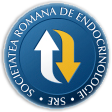
- Login
- Register
- Home/Current Issue
- About the journal
- Editorial board
- Online submission
- Instructions for authors
- Subscriptions
- Foundation Acta Endocrinologica
- Archive
- Contact
 Romanian Academy
Romanian Academy
 The Publishing House of the Romanian Academy
The Publishing House of the Romanian Academy

ACTA ENDOCRINOLOGICA (BUC)
The International Journal of Romanian Society of Endocrinology / Registered in 1938in Web of Science Master Journal List
Acta Endocrinologica(Bucharest) is live in PubMed Central
Journal Impact Factor - click here.

-
Endocrine Care
Ataikiru U, Iacob R, Chirita-Emandi A, Galinescu M, Miron I, Popoiu C, Boia E
A 10-Year Study of Children with Gonadal Tumors and Disorders of Sex Differentiation, in RomaniaActa Endo (Buc) 2023 19(4): 487-496 doi: 10.4183/aeb.2023.487
AbstractContext. Children having gonadal tumors and disorder of sex differentiation (DSD) are rare. Objective. To investigate the presentation of DSD children with malignant gonadal tumors. Methods. A retrospective study from 2010- 2020, that evaluated 17 children with DSD, including 13 females, eight months to 16 years, with congenital adrenal hyperplasia, 5-alpha reductase deficiency, androgen insensitivity syndrome, Turner, Sywer, and Klinefelter syndromes. Results. Ten children had malignant gonadal tumor; nine had germ cell tumors and one person granulosa cell tumors, while seven children with non-malignant tumor had gonadoblastoma, cystadenoma (five children), and cysts. Systemic malformations, obesity, elevated tumor markers, and psychosocial issues were observed in 90%, 90%, 70%, and 50% of children with malignancy unlike 28.6%, 42.9%, 14.35%, and 57.1% children without malignancy respectively. Most (9/10) children >12 years, had psychosocial issues, unlike 0/7 children ≤12 years. From 8/17 children presenting with symptoms suggestive of tumor, 75% had malignancy, while from 9/17 children with DSD presentation, 44% had malignant tumors. Malignancy was observed in 3/10 children between eight months to age six, while 7/10 children had stage 1-2 tumors. We reported a child, identified as female, aged 13 years, with partial androgen insensivity syndrome (PAIS) 46,XY, and testicular papillary serous cystadenoma with genomic variant AR NM_000044.4:c.2750del. p.(F917Sfs*27) chromosome Xq12, never published in people with PAIS nor population databases (GnomAD). Conclusion. DSD diagnosis raises numerous challenges. People with DSD have increased risk of malignancy, especially when obesity and, systemic malformations are present; also, psychosocial issues in these children are associated with postpubertal age. -
Editorial
Virgolici B, Mohora M, Virgolici HM, Posea M, Martin RE
Hematological Indices Related to Vitamin D Deficiency in Obese ChildrenActa Endo (Buc) 2022 18(4): 488-493 doi: 10.4183/aeb.2022.488
AbstractIntroduction. Vitamin D is involved in differentiation and induction of erythropoiesis in bone marrow cells. Aim. We compared the serum 25(OH) vitamin D level in obese children versus control and found correlations between vitamin D level and hematological indices in obese children. Materials and methods. 25 overweight and obese patients and 15 normal weight children were enrolled in an observational study . Results. In obese children, the serum level of 25(OH) vitamin D was significantly (p<0.04) lower (20.60 ng/mL) compared with the value from normal weight ones (25.63 ng/mL) and the body fat percentage BFP was higher. We found a positive correlation (r=0.44, p<0.05) between serum vitamin D and hemoglobin level and a negative one between serum vitamin D and the number of platelets (r= -0.43, p<0.05). Also, the serum iron was at the lower normal limit in the obese children and negatively correlated with the percent of the body fat (r= -0,62, p<0.05). Conclusion. Obese children have vitamin D deficiency. The hemoglobin level and the number of platelets are correlated with the serum level of 25(OH) vitamin D. Supplements with vitamin D may have pleiotropic effects, including those on bone marrow activity. -
Notes & Comments
Tarnoki AD, Tarnoki D.L., Molnar A.A., Berczi V., Garami Z., Karlinger K
Contribution of Genes to the Changes on Body Composition Components: a Two-Year Longitudinal Study in a Small Cohort of TwinsActa Endo (Buc) 2013 9(3): 489-498 doi: 10.4183/aeb.2013.489
AbstractContext. High heritability of body composition variables is well-known, however, longitudinal effect of genes is still unclear. Objective. The aim of this study was to investigate the pattern of longitudinal changes in anthropometric variables in a small cohort of twins. Design. Longitudinal classical twin study, performed in 2009 and in 2011 on the same twin pairs. Subjects and Methods. Eighteen healthy adult Hungarian twin pairs (13 monozygotic [MZ], 5 dizygotic [DZ]; mean age 54.0 ± 15.2 years; average body mass index 24.4±5.4 kg/m2 in 2009 and 25.1±4.7 kg/m2 in 2011, respectively) recruited from the Hungarian Twin Registry underwent bioimpedance analysis (OMRON). Results. Significant, higher positive intrapair correlations were detected in the longitudinal change in weight (p<0.05), body fat mass (p<0.01), non-fat mass (p<0.01), and body mass index (p<0.01) in MZ compared to DZ twins, suggesting the possibility of longitudinal genetic determinants. Negative associations were observed with regard to the two-year change in waist and hip circumferences, suggesting the longitudinal role of environmental factors in these phenotypes. Conclusions. The findings of the present human twin study suggest that weight, body fat mass, non-fat mass, and body mass index are determined genetically and longer exposure to pathologic environmental factors is necessary to elicit alterations in the regulation of these parameters. Longer-term confirmation in a larger sample is required to confirm these results. -
Case Report
Celik O, Celik H, Guldiken S, Turkmen MT, Koten M
Sialoadenosis in a Patient with Diabetes Mellitus: Case ReportActa Endo (Buc) 2012 8(3): 489-493 doi: 10.4183/aeb.2012.489
AbstractSialadenosis is an uncommon, noninflammatory condition which usually causes bilateral, diffuse enlargement of the\r\nsalivary glands, particularly of the parotid. Sialadenosis has been associated most often with alcoholism, eating disorders,\r\nmalnutrition, medications and diabetes mellitus. Herein, we describe a case report of a patient with sialadenosis precipitated by poorly controlled diabetes mellitus. -
Editorial
Figueroa AL, Hanzu F, Gomis R
Nutrition and the Clock GeneActa Endo (Buc) 2015 11(4): 489-491 doi: 10.4183/aeb.2015.489
AbstractA number of recent studies in animals and humans have linked energy regulation and the circadian clock at the molecular, physiological and behavioural levels, concluding that disruption of clock genes results in metabolic dysregulation. The search to understand the causes of obesity and diabetes and the development of new therapeutic strategies have mostly focused on caloric intake and energy balance. In this review, we present a global overview of the circadian clock as a critical interface between nutrition and homeostasis. -
Endocrine Care
El-Ziny MA, Hegazi MA, El-Hawary AK, El-Sharkawy AA, Abd El-Rahman A, El-Sonn WA
Hormonal, sonographic, and body composition changes in egyptian adolescent girls with hyperandrogenic manifestationsActa Endo (Buc) 2009 5(4): 489-500 doi: 10.4183/aeb.2009.489
AbstractObjective. Hyperandrogenism is any clinical or laboratory evidence of androgen excess in women. This study was conducted to assess the prevalence of hyperandrogenic disorders especially polycystic ovary syndrome in a random sample of adolescent girls, as well as to identify the clinical, hormonal, ultrasonic, and body composition characteristics associated with such disorders. Patients and Methods. Two hundred school girls (15-18 years old) were selected by random sampling from different secondary schools, and screened for hyperandrogenic disorders by a validated questionnaire and subjected to thorough confirmatory investigations. Results. Twenty-five out of the 200 students were thoroughly evaluated. Eighteen adolescents of the examined students (72%) were finally diagnosed with polycystic ovary syndrome, 5 (20%) with idiopathic hyperandrogenism and 2 (8%) with non-classic congenital adrenal hyperplasia . Despite normal weight percentiles and body mass index for age and sex in 83.3% and 88.9% of students with polycystic ovary syndrome respectively, fat mass, trunk fat percentage, trunk fat mass, and trunk free fat were significantly higher in polycystic ovary syndrome patients compared to controls. Conclusions. Polycystic ovary syndrome was the most common hyperandrogenic disorder in this study. Combined menstrual dysfunction and clinical hyperandrogenism had adequate sensitivity and high specificity in the prediction of polycystic ovary syndrome. Pulse inversion harmonic imaging is an adequately sensitive preferential diagnostic tool of polycystic ovary syndrome in virgin adolescents who may have central adiposity. Body composition assessment by bioelectrical impedence is valuable in detecting central adiposity which could be correlated to parameters of insulin resistance. -
Images in Endocrinology
Dumitrascu A, Fica SV
Sinus oblilteration in dwarfismActa Endo (Buc) 2005 1(4): 489-489 doi: 10.4183/aeb.2005.489
-
Endocrine Care
Aysan E, Korkmaz YY, Hacihasanoglu E
A New Method for Intraoperative Definitive Diagnosis of Inadvertent Parathyroidectomy During Central Neck DissectionActa Endo (Buc) 2024 20(4): 490-493 doi: 10.4183/aeb.2024.490
AbstractBackground. The most serious complication of central neck dissection (CND) is inadvertent parathyroidectomy. There is no definitive method for intraoperative diagnosis of this complication. Method. We studied on CND indicated 17 thyroid cancer patients (14 female, 3 male, age range: 21-67, mean age: 43.4). The excised CND material was kept in 50 ml of normal saline for 30 minutes. A 2 ml sample was taken from this fluid and sent to biochemistry for rapid parathyroid hormone (PTH) measurement. Results. PTH values were <10pg/mL in 14 patients. PTH values of three patients were very high (112pg/mL, 167pg/mL, 210pg/mL respectively). When the excised tissue in these patients was evaluated intraoperatively with loop glasses, one parathyroid tissue was found in each of the three cases and these were auto-transplanted intramuscularly. After this procedure we kept CND tissue material again in another normal saline of 50mL in 30 minutes and PTH was measured. The values came back as <10pg/mL. No parathyroid gland was found in any case in the postoperative routine histopathological evaluation. No patient had symptoms of hypocalcemia during the eightweeks postoperative follow-up. Conclusion. Inadvertent parathyroidectomy due to CND is a serious complication. This complication can be prevented with the simple method we recommend here. -
Notes & Comments
Lichiardopol C, Coculescu M
Female reproductive tract misdevelopment: comments on Mayer Rokitanski Kuster Hauser syndromeActa Endo (Buc) 2005 1(4): 491-498 doi: 10.4183/aeb.2005.491
AbstractMayer Rokitanski Kuster Hauser (MRKH) syndrome or the congenital absence of the uterus and vagina accounts for 15% of primary amenorrhea cases and is second to Turner syndrome as the most common cause. Affected individuals have a 46,XX chromosomial constitution and normal secondary sex characteristics. Symmetric uterine buds and fallopian tubes are consistant with type A and asymmetric - with type B MRKH syndrome, the latter being associated with other congenital anomalies (renal, skeletal, ear ovarian and cardiac). We studied four patients aged 18-45 years in which type A MRKH syndrome was established by clinical and gynaecological examination, pelvic and abdominal ultrasonography, explorative laparoscopy cytogenetic analysis and hormonal evaluation. Associated disorders were breast fibroadenoma and Graves disease in one case, congenital glaucoma, keratitis, hypocalcemia and simple goiter in another case and polycystic ovaries with clinical signs of hyperandrogenism in the case which can be related to the genetic defect underlying MRKH syndrome. The presence of associated disorders complicates the management of MRKH syndrome which is complex, requires multidisciplinary approach and decreases further the patient?s quality of life. -
Endocrine Care
Caglar E, Ugurlu S, Zuhur SS, Yetkin D, Kadioglu P
Disease Control Using Various Treatment Modalities in AcromegalyActa Endo (Buc) 2011 7(4): 491-502 doi: 10.4183/aeb.2011.491
AbstractAim. This study aimed to investigate the clinical presentation and treatment outcomes of newly diagnosed acromegaly patients treated with various combinations\r\nof treatment modalities.\r\nMaterials and Methods. Eighty-four acromegaly patients (42 female, 42 male, mean age 40.29?13.32 y), followed and\r\ntreated between 2000 and 2010 were included. Data on patient demographics, delay between onset of symptoms and the\r\ndiagnosis, details of treatments, and treatment- or disease-related morbidity and mortality were collected and analyzed. The median delay time for diagnosis was 60.71 ? 56.19 months. Patients received various combinations of surgery, gamma knife radiotherapy or conventional radiotherapy,\r\nlong acting somatostatin analogue, and dopamine agonist.\r\nResults. After ten years of treatment, median GH and IGF-1 values decreased from 13.7 ng/mL (IQR: 5.3- 34) to 1.04\r\nng/mL (IQR: 0.52-2.7) and from 600 μg/L (IQR: 460.5-787.5) to 194 μg/L (IQR :157-356), respectively (p<0.0001).\r\nMedian GH during 75 g oral glucose tolerance test (OGTT) decreased from 4.35 ng/mL (IQR: 1.87-13.15) to 1.40 ng/mL\r\n(IQR: 0.60-3.40) (p<0.0001). Fifty patients (59.5%) were in remission according to IGF-1 values and 52 patients (62 %) were cured according to nadir GH during OGTT respectively. The mortality rate was 5.9%.\r\nIn conclusion. Strict biochemical control following appropriate intervention significantly reduces both morbidity and mortality in acromegaly patients.